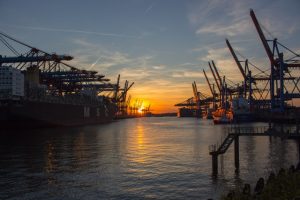PSA Singapore operates the world’s largest transhipment hub, managing 30.62 million TEUs of containers in 2016. Technology solutions like automated cranes, e-business portals and ERP systems are utilised to address a lot of their challenges. Some questions were asked…
 How is technology helping PSA retain its standing as the world’s biggest shipping hub?
How is technology helping PSA retain its standing as the world’s biggest shipping hub?
Technology is a vital enabler of change to PSA. We’ve been very proactive in taking advantage of new technologies to improve our port operations. We were among the first early adopters of computerizing port operations with our proprietary CITOS terminal operations systems, in addition to our PORTNET community systems. Today, our systems ensure that our ports continue to function economically, and with plenty of speed.
There’s an equal emphasis on innovation. We’re starting to explore areas such as automation, data analytics, e-business functions and other new technologies. One example is our package of Automated Guided Vehicles, which are now undergoing testing at Pasir Panjang Terminal. We’re set to have 30 vehicles at the end of the year.
For live surgeries, we’ve deployed over 140 automated yard cranes. These are the cranes that pick up boxes out of the lawn and on the transport vehicles including various low loaders on hire. This is on a scale that’s unprecedented, nowhere in the world will you see this extensive installation of automatic cranes in one location.
This is the type of accent PSA places on automation and technology. A couple of years back, we began our venture capital arm, also called PSA Unboxed. We spent S$20 million in an incubator program for startups to come on board. We hope to locate new and interesting startups which will help to create new and innovative solutions that may revolutionize the way we’re doing our business, and contribute to see how we could influence the distribution chain.
We’re also trying to tap on other emerging technologies – IoT, cloud, virtualization, blockchain, augmented and virtual reality, AI and robotics. Overall, we’ve dedicated about S$150 million to innovation projects under our Container Port 4.0 program.
Can you explain some of the IT challenges PSA is facing?
If our clients want to move boxes from 1 point of the world to another, we’re accountable for making it happen. Sounds simple enough, but we’re discussing a size of 30 million boxes in a year, with hardly any room for error, with an excellent safety record, without missing our client schedules, and doing slab crane hire with efficiency and speed.
Within the industry, many changes have taken place in the past couple of months. We’ve seen new significant shipping alliances being formed, and these are translated into plenty of motion and changing business patterns as we manage our terminal operations. We’re also seeing unprecedented peaks within our organization.
For each business challenge, it’s reasonable to say that technology is not the only solution, it’s technology combined with changes you make concerning business processes. In the context of transport alliance changes, there were lots of unforeseen ad hoc adjustments. It highlighted the peaks, suddenly you’ve got a burst of up to 100,000 containers to be handled every day.
So how has that been an issue for IT support solutions? Obviously, one is the load factor, when you will need to ramp up the abilities. With our investments made in Dell EMC’s hyperconverged infrastructure, we now have an amount of flexibility, to really be in a position to ramp up, to overcome some of those peak volumes. However, as I said, this is simply one part of things. I will not discredit the other attempts concerning adjusting the business processes and the people aspect.
What were your key factors in choosing a technology partner in PSA’s transformational journey?
We took a holistic perspective by looking at three viewpoints – tech, process and people.
Especially, for the people part, our emphasis was to look both internally and externally. Internally, with this evolving landscape of IT managed services and providers, with new competencies and new skillsets, how do you really get your people up to speed with new technologies?
Externally, we looked closely at our technology partners. It’s a comprehensive approach. It’s not just their technical and business capabilities, but how well they know us, what’s their solution portfolio, and more importantly, their willingness to collaborate with PSA in attempting to invent this long term relationship and addressing long term challenges. We’re here for the long haul, and we want to make sure that for our investment options in engineering, we find the proper people to travel with.


